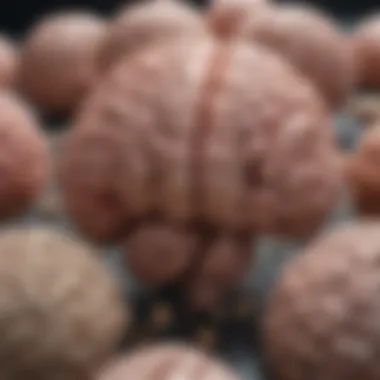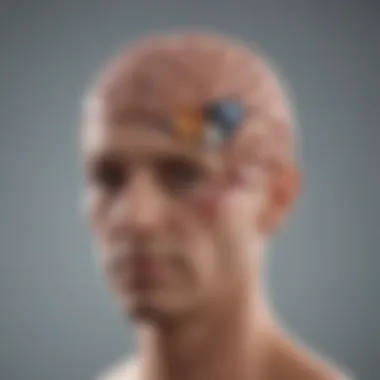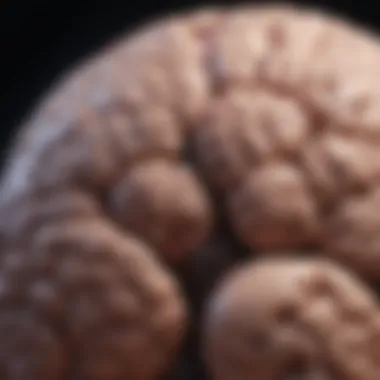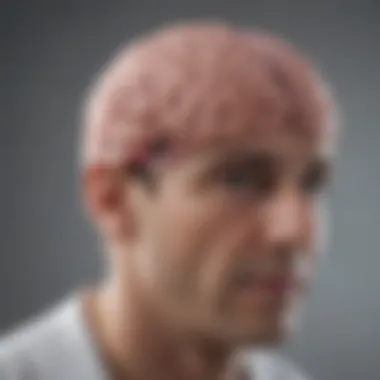Understanding Brain Lesions: A Detailed Exploration


Intro
Brain lesions represent a significant aspect of neurological health. They encompass any abnormality found in the brain tissue which can affect cognitive and physical functions. Understanding these lesions is vital for effective diagnosis and treatment. The implications of brain lesions are far-reaching, influencing both clinical practices and research initiatives. This article strives to elucidate these complex conditions, facilitating better comprehension among students, researchers, educators, and professionals engaged in the field.
Research Overview
Neurological research has made remarkable strides in understanding brain lesions. This overview addresses methodologies and explores the significance of these findings within the broader context of neuroscience.
Methodological Approaches
Research on brain lesions employs diverse methodologies, applying both qualitative and quantitative approaches. These include:
- Imaging Techniques: MRI (Magnetic Resonance Imaging) and CT (Computed Tomography) scans are commonly used to visualize brain structures and identify lesions.
- Histopathology: This involves studying tissue samples under a microscope to reveal cellular changes and abnormalities.
- Neuropsychological Testing: Assessing cognitive functions helps to correlate the location and extent of lesions with potential impairments.
These diverse methods allow researchers to gather comprehensive insights into brain lesions, their types, and how they manifest in different patient demographics.
Significance and Implications
The study of brain lesions holds considerable importance in both clinical and academic settings.
Understanding brain lesions aids in identifying potential neurological disorders, offering paths for earlier intervention and more targeted therapies.
In medical practice, diagnosing lesions can direct clinical decisions. Additionally, research into their etiology contributes to broader understanding of brain health and neurological diseases. This intersection of knowledge continues to enhance neurorehabilitation efforts and improve patient outcomes.
Current Trends in Science
Advancements in science continuously shape our understanding of brain lesions. New techniques and tools are emerging that make diagnosis and treatment more precise.
Innovative Techniques and Tools
The landscape of brain lesion research is evolving. Notable trends include:
- Artificial Intelligence: AI algorithms help improve diagnostic accuracy by analyzing brain imaging data quickly.
- Advanced Imaging: Techniques such as diffusion tensor imaging (DTI) provide new insights into white matter integrity and connectivity.
- Biomarker Discovery: Identifying specific biomarkers for different types of brain lesions supports individualized treatment strategies.
These tools not only enhance research methodology but also refine clinical practices, leading to improved patient management.
Interdisciplinary Connections
The exploration of brain lesions involves collaboration across multiple disciplines. Neuroscience, psychology, and radiology intersect to create a comprehensive approach to understanding these complex structures. The synergy between these fields fosters a better understanding of brain lesions while driving innovation in diagnostic and therapeutic strategies.
This cooperation enhances the depth and breadth of knowledge, making it essential for advancing both treatment approaches and research endeavors in the field of neurology.
Definition and Overview of Brain Lesions
Understanding brain lesions requires a holistic view of how they impact overall neurological health. The brain is an intricate organ, and any disruption caused by lesions can lead to significant cognitive and physical impairments. Having a clear definition and overview serves as the cornerstone for further discussions on types, causes, diagnostics, and treatments related to brain lesions.
By grasping the fundamental concepts of brain lesions, readers become better informed about the nuances of neurological disorders. This knowledge proves beneficial not just for students and researchers, but also for healthcare professionals who interact with patients experiencing these conditions. Awareness of how lesions manifest and their implications can influence both treatment plans and patient care strategies.
What is a Brain Lesion?
A brain lesion refers to any abnormal change in the brain's structure. These alterations might stem from various causes, including injury, infection, or disease. Lesions can be focal, meaning they are localized to a specific area, or diffuse, affecting more extensive brain regions. The significance of brain lesions lies in their capacity to disrupt normal functions. They can vary greatly in size, shape, and location, contributing to a wide range of symptoms.
It is crucial to differentiate between the types of brain lesions for accurate diagnosis and treatment. For example, traumatic lesions may result from an accident, while tumor-induced lesions arise from the presence of growths, whether benign or malignant. A proper understanding can enhance both research and clinical practices, facilitating targeted interventions.
Historical Context of Brain Lesion Research
The exploration of brain lesions has a robust history that intertwines with the evolution of neuroscience itself. Initially, ancient scholars like Hippocrates speculated about the connection between brain changes and behavior. However, systematic research began in earnest during the 19th century, marked by breakthroughs in pathology and medical imaging.
Investigations from pioneers such as Paul Broca and Carl Wernicke have laid the groundwork for understanding the relationship between specific brain regions and associated functions. Their work elucidated how damage to particular areas could lead to deficits in speech and language.
As diagnostic tools improved, particularly with the advent of magnetic resonance imaging (MRI) and computed tomography (CT), researchers gained unprecedented access to observe alterations within the living brain. This has paved the way for a more profound understanding of the functional implications of brain lesions, leading to innovative treatment options. Today, ongoing research continues to unravel the complexities of brain lesions, emphasizing their significance in both clinical and academic settings.
Knowledge of brain lesions not only informs healthcare but also enhances our grasp of the intricate workings of the human brain.
Types of Brain Lesions


Understanding the different types of brain lesions is crucial in the field of neurology. Brain lesions can vary widely in origin, nature, and impact. The identification of the specific type is essential for appropriate diagnosis and treatment. This section reviews five primary categories of brain lesions, each presenting unique challenges and implications.
Traumatic Brain Lesions
Traumatic brain lesions result from external forces applied to the head. These can occur during activities such as sports or vehicle accidents. The injury may vary from mild concussions to severe traumatic brain injuries (TBI).
The effects of traumatic brain lesions can manifest immediately or develop over time. Symptoms may include headaches, confusion, and nausea, among others. Understanding the mechanism of injury is vital for treatment decisions. Rehabilitation may often be necessary depending on the severity.
Tumor-Induced Brain Lesions
Tumor-induced lesions arise when abnormal cells grow in the brain, forming a mass. These lesions can be benign or malignant. The growth can cause pressure on surrounding brain tissues, leading to neurological symptoms.
Tumors can originate in the brain or metastasize from other parts of the body. Diagnostic imaging, like MRI, is critical in identifying these lesions. Treatments often include surgery, radiation, and chemotherapy. Long-term monitoring is important as recurrence rates can vary.
Vascular Brain Lesions
Vascular brain lesions are associated with blood vessel abnormalities. They often result from strokes, aneurysms, or vascular malformations. These lesions can disrupt blood flow, leading to brain tissue damage.
The onset of symptoms can be abrupt, often involving sudden headaches or neurological deficits. Accurate diagnosis requires imaging techniques to visualize blood vessels. Early intervention in cases of stroke can minimize potential damage and improve recovery outcomes.
Infectious Brain Lesions
Infectious brain lesions occur due to pathogens like bacteria, viruses, or fungi. These infections can lead to conditions like encephalitis or meningitis. The inflammation of the brain can compromise neurological function, presenting severe symptoms.
Treatment typically involves antimicrobial therapies tailored to the specific pathogen involved. Vigilance in recognizing signs early is important to prevent complications. Individuals with compromised immune systems may be at higher risk.
Demyelinating Brain Lesions
Demyelinating lesions are characterized by the loss of myelin, a protective layer around nerve fibers. Conditions such as multiple sclerosis cause such lesions. The resulting symptoms can include motor and cognitive challenges, depending on affected brain areas.
Management of demyelinating lesions focuses on slowing disease progression and managing symptoms. Treatment strategies may include corticosteroids and other immunomodulatory agents. Regular follow-ups are necessary to adapt treatment strategies effectively.
Each type of brain lesion presents unique challenges and opportunities for diagnosis and treatment. Understanding their specific characteristics is essential for effective management.
Causes of Brain Lesions
Understanding the causes of brain lesions is crucial for both diagnosis and treatment. Identifying the underlying reasons helps in managing the complications arising from such conditions. Each cause can lead to various types of brain lesions, potentially changing how they affect neurological function. Comprehensive knowledge in this area is beneficial for students, researchers, and professionals working with neurological diseases.
Genetic Factors
Genetic factors contribute significantly to the formation and progression of brain lesions. Certain inherited conditions can predispose individuals to neurological disorders. For example, some forms of neurodegeneration, like Huntington's disease, are directly linked to specific genetic mutations. These genetic variations often lead to the development of lesions over time.
Key genetic factors include:
- Mutations in genes: Alterations in genes such as the TP53 gene can result in increased susceptibility to brain tumors.
- Familial connections: A family history of neurological diseases often correlates with a higher incidence of lesions.
- Chromosomal abnormalities: Issues like Down syndrome can lead to a range of neurological complications, including lesion formation.
The interplay between genetics and brain lesions suggests an area ripe for further investigation, especially for developing targeted therapies.
Environmental Influences
Environmental influences play a significant role in the occurrence of brain lesions. Factors such as exposure to toxins, infections, and lifestyle choices can all impact brain health.
Important considerations under this category include:
- Toxin exposure: Chemicals like lead and pesticides are known to have toxic effects on the nervous system. Prolonged exposure can contribute to brain lesions.
- Infectious agents: Infections such as herpes simplex virus can lead to encephalitis, resulting in brain lesions.
- Iron deficiency: Insufficient iron during development stages may increase vulnerability to conditions leading to lesions.
"Environmental factors are often overlooked, but they can significantly alter the pathogenesis of brain lesions."
Recognizing the impact of lifestyle choices, such as diet and exercise, can also promote better brain health and mitigate risks associated with environmental influences.
Pathophysiological Mechanisms
Pathophysiological mechanisms involve the biological processes that lead to the formation of brain lesions. Understanding these mechanisms is vital for developing effective treatment strategies.
Key aspects include:


- Inflammation: Chronic inflammation can lead to neuronal damage, promoting lesions. Conditions like multiple sclerosis highlight this mechanism.
- Disrupted blood flow: Ischemia or lack of blood supply can cause cell death. This often results in the formation of lesions post-stroke.
- Metabolic dysfunction: Disorders that affect metabolism, such as diabetes, can cause changes in neuronal integrity, leading to lesions.
Investigating these mechanisms can provide deeper insights into preventing and treating brain lesions effectively.
Diagnostic Procedures for Brain Lesions
In the field of neurology, diagnosing brain lesions is crucial for understanding underlying health issues. Accurate diagnosis informs treatment strategies, impacts patient outcomes, and guides further research. Diagnostic procedures help identify the lesion type, location, and extent, which is critical for tailored interventions. By using various techniques, healthcare professionals can assess the physiological and functional status of the brain. This section delves into essential diagnostic methods that aid in exploring brain lesions.
Neuroimaging Techniques
Neuroimaging is an essential aspect of diagnosing brain lesions. It provides visual insight into brain structure and functions. Several imaging modalities exist, each offering unique benefits and drawbacks.
Magnetic Resonance Imaging (MRI)
MRI is highly regarded for its detailed images of brain anatomy. It employs strong magnetic fields and radio waves to generate high-resolution images, distinguishing brain tissue types effectively. One of its key features is the contrast it offers between healthy and abnormal tissues. This makes MRI a preferred choice for identifying tumors, demyelinating diseases, and other lesions.
The primary advantage of MRI is its non-invasive nature, avoiding radiation exposure that other imaging methods may involve. However, it is worth noting that MRI scans can be more time-consuming and may not be as effective in evaluating acute hemorrhages compared to other imaging modalities.
Computed Tomography (CT)
CT scans utilize X-rays to produce cross-sectional images of the brain. This method is known for its speed and effectiveness, especially in emergency settings. It is particularly valuable in detecting acute bleeding or structural abnormalities quickly. One of the remarkable features of CT is its ability to show bone structures, which is not possible with MRI.
The benefit of CT lies in its rapid execution. This can be crucial when immediate diagnosis is needed, such as in suspected strokes or trauma cases. However, the downside involves exposure to ionizing radiation, presenting a risk with repeated use.
Positron Emission Tomography (PET)
PET scans focus on functional imaging. They involve a radioactive tracer that enables visualization of metabolic processes in the brain. This scan is beneficial for evaluating brain lesions associated with neurological conditions because it provides insight into the activity level of specific brain regions.
An outstanding characteristic of PET is its ability to detect changes in brain function before structural changes become apparent. However, PET scans are less commonly used for routine diagnosis of brain lesions due to the complexity and cost of the procedure.
Biopsy and Histopathological Analysis
Biopsy involves the extraction of tissue samples for examination. This procedure is essential for confirming the nature of a brain lesion, particularly in cases of tumors. Histopathological analysis involves studying the samples under a microscope to identify cellular features, such as malignancy. This method adds significant value to diagnosis, allowing for targeted treatment in the weeks following discovering the lesion.
Electrophysiological Assessments
Electrophysiological techniques, including Electroencephalography (EEG), assess the electrical activity of the brain. They are vital for diagnosing conditions like epilepsy associated with brain lesions. These assessments can help identify the functional impact of the lesions, providing insights into how they affect patient behavior and cognition. While not directly imaging the lesions, these tests are crucial for a holistic understanding of the patient's neurological health.
"A correct diagnosis is the cornerstone of effective treatment."
In summary, diagnostic procedures are indispensable for recognizing brain lesions accurately. Each technique has unique strengths and limitations, highlighting the need for an integrated approach. By combining different methods, healthcare providers can achieve a comprehensive understanding of brain health.
Impact of Brain Lesions on Function
Brain lesions can have significant effects on both cognitive and physical functions. Understanding these impacts is crucial for both medical professionals and patients. Cognitive impairments can disrupt daily life and professional performance, while physical manifestations change mobility and quality of life. Treatment strategies must consider these repercussions for effective recovery and rehabilitation.
Cognitive Impairments
Cognitive impairments are a common consequence of brain lesions. They can affect various mental processes such as memory, language, and executive functions.
Memory Disorders
Memory disorders resulting from brain lesions often lead to difficulties in retaining information or recalling past events. This aspect is vital as it directly influences one’s ability to learn and adapt. Memory disorders can manifest in various forms, including anterograde amnesia, where new memories cannot be formed. This is particularly concerning, as the affected individuals struggle with daily tasks that require recall and recognition. The unique feature of memory disorders lies in their direct impact on personal identity and independence. While therapy may aid some recovery, the extent can vary greatly, making this a challenging aspect in rehabilitation efforts.
Language Deficits
Language deficits are another critical concern linked to cognitive impairments due to brain lesions. These deficits might manifest as difficulties in speaking, understanding speech, or forming written language. The key characteristic of language deficits is their effect on communication, which can drastically change how individuals interact socially and professionally. This aspect is essential for patients, as communication is the foundation of relationships. A unique feature here is that language skills can often be targeted in therapy, improving functionality over time. However, the recovery process can be slow, and not all individuals fully regain their previous communication skills.
Executive Function Challenges
Executive function challenges encompass a range of difficulties involving planning, organization, and decision-making. This type of cognitive impairment is critical as it affects daily life and occupational functionality. The key characteristic here is the ability to manage tasks effectively. Often, individuals may experience difficulties prioritizing tasks or managing time efficiently, leading to frustration and decreased productivity. This feature highlights the complex interplay between cognitive processes and real-world applications. While there are interventions available to support these challenges, some patients may struggle to find effective strategies for coping, making this a complicated topic of discussion.
Physical Manifestations
Physical manifestations of brain lesions can considerably alter a person’s ability to engage in everyday activities. These include issues related to motor skills, seizures, and coordination.


Motor Skill Difficulties
Motor skill difficulties arise when the brain's ability to control muscle movement is impaired. This aspect is significant because it can hinder basic functions like walking, writing, or even eating. The key characteristic of motor skill difficulties is the range of motion issues or weakness that affects mobility. The unique feature here is that rehabilitation programs can address these impairments, although recovery might be inconsistent. Also, patients may experience frustration due to the fluctuating nature of their capabilities.
Seizures
Seizures represent another serious concern linked to brain lesions. This specific aspect is crucial, as they can occur unpredictably and impact safety. The key characteristic of seizures is the disruption of normal brain activity, which can lead to loss of consciousness or muscle control. Seizures are a major concern due to their potential life-threatening nature. A unique factor is that while anti-seizure medications may help manage this condition, side effects can impact overall quality of life. This makes navigating treatment options essential.
Coordination Issues
Coordination issues often arise when brain lesions disrupt the brain's ability to communicate with muscles. This specific aspect can lead to difficulties in balance and precision in movements. The key characteristic of coordination issues is that they can severely limit a person's ability to perform tasks that require fine motor skills. A unique feature of these issues is that balance training and physical therapy can improve outcomes, but results may vary considerably among individuals. This variability can lead to prolonged challenges in rehabilitation efforts.
Treatment Approaches for Brain Lesions
The treatment of brain lesions involves a multifaceted approach, combining various medical strategies tailored to the specific type, cause, and location of the lesion. Understanding these treatments is essential as they directly impact both the short-term management and long-term outcomes of patients. Each approach offers unique benefits and challenges, which must be weighed carefully to ensure optimal care.
Surgical Interventions
Surgical intervention is often necessary for brain lesions that are either causing significant symptoms, such as pressure on surrounding brain tissue, or those that are suspected to be malignant. For example, in cases of tumor-induced lesions, neurosurgeons may opt for procedures like craniotomy for tumor resection. The direct benefits of surgery can include immediate relief from symptoms, the potential for complete removal of abnormal tissue, and providing a definitive diagnosis through histopathological examination. However, the risks associated with surgery include infection, bleeding, and sometimes neurological deficits. Thus, a thorough pre-operative assessment is critical to weigh these factors against the potential benefits.
Radiation Therapy
Radiation therapy serves as another viable treatment option, particularly for tumors that cannot be completely removed surgically. Techniques such as stereotactic radiosurgery allow for targeted radiation to precisely attack tumorous tissue while sparing adjacent healthy brain structures. This approach is beneficial for patients who are not candidates for surgery due to age, overall health, or tumor location. However, there are long-term considerations, such as radiation necrosis, which can develop years after treatment.
Pharmacological Treatments
Pharmacological treatments also play a significant role in managing symptoms and addressing underlying conditions related to brain lesions. These medications may include:
Antiepileptic Drugs
Antiepileptic drugs are often prescribed when lesions lead to the occurrence of seizures. These medications help stabilize neuronal activity, helping to prevent seizures from disrupting daily life. Notable examples include lamotrigine and levetiracetam. Their key characteristic is the ability to control seizures without causing significant sedation, making them a popular choice among clinicians.
Moreover, the unique feature of antiepileptic drugs lies in their varied mechanisms of action, thus allowing for personalized treatment based on the individual’s specific seizure type or frequency. However, some of these drugs can have side effects such as dizziness or fatigue, leading to consideration of the patient’s lifestyle and the potential for drug interactions.
Corticosteroids
Corticosteroids are another important pharmacological option in the management of brain lesions, particularly in cases of inflammation or edema surrounding a lesion. These drugs, such as dexamethasone, help reduce swelling and alleviate pressure symptoms. The principal benefit is rapid symptom relief, which can significantly enhance quality of life.
This class of drugs must be used with caution, as they can cause side effects including immune suppression, weight gain, and mood changes. Consequently, the risk-benefit analysis becomes critical for long-term management.
Rehabilitation and Supportive Care
After initial treatment, rehabilitation and supportive care are vital to assist patients in regaining functions that may have been impacted by brain lesions. This may involve physical therapy to improve motor skills, occupational therapy for daily living activities, and speech therapy if language functions are affected. Supportive measures such as counseling may also be needed to help patients cope with emotional and cognitive changes post-treatment.
"A comprehensive care approach post-treatment promotes recovery and improves quality of life."
Integrating these treatment modalities can provide a coherent strategy for managing brain lesions. Each element, from surgical interventions to rehabilitation, is crucial in addressing both the medical and holistic needs of patients.
Future Directions in Brain Lesion Research
The pursuit of understanding brain lesions continues to evolve. Research in this field not only aims to elucidate the mechanisms behind lesions but also seeks innovative paths for diagnosis and treatment. Therefore, identifying future directions can significantly enhance our approach toward managing brain health. The development of new methodologies and technologies allows for a more nuanced perspective on lesions. Here, we explore critical aspects that may shape future endeavors in this domain.
Emerging Technologies
Technological advancements play a pivotal role in reshaping the landscape of brain lesion research. Innovations like artificial intelligence and machine learning have begun to find their place in neuroimaging analysis, improving detection accuracy and prediction models. For instance, AI can aid in recognizing subtle changes in scans that traditional methods might miss. Additionally, tools like high-resolution diffusion tensor imaging can provide insight into the structural integrity of white matter affected by lesions.
"Emerging technologies may lead to earlier identification and more precise treatment of brain lesions, benefiting patient outcomes immensely."
Other promising technologies include 3D printing and augmented reality, which facilitate better surgical planning. These technologies could enhance the precision of interventions, minimizing risks associated with surgery. Furthermore, wearable devices are entering the research field, enabling real-time monitoring of neurological symptoms, thereby creating a feedback loop for continuous investigation.
Novel Therapeutic Strategies
As our understanding of brain lesions deepens, so do the experimental therapies being considered for effective treatment. Combining traditional pharmacological approaches with cutting-edge therapies opens new possibilities for managing brain lesions. Researchers are exploring agents that could promote neuroprotection or repair, such as stem cell therapies. These innovative treatments could potentially reverse some of the functional impairments linked to lesions.
Intriguingly, gene therapy is also being investigated as a way to address genetic factors contributing to lesions. This method seeks to correct the underlying genetic issues, providing a longer-term solution. Precision medicine tailored to individual genetic profiles could enhance treatment effectiveness, optimizing outcomes for patients.
Interdisciplinary Approaches
Addressing brain lesions requires a collaborative effort across various disciplines. Neurologists, neurosurgeons, radiologists, and rehabilitation specialists must work in tandem to refine diagnosis and management strategies. Interdisciplinary teams can integrate diverse understandings and expertise, fostering comprehensive patient care.
Moreover, building alliances with technology experts could expedite the introduction of innovative tools in clinical settings. This cross-pollination of ideas will aid dialectical growth in both research and application. As professionals from different backgrounds converge, we expect a holistic approach to invasion into the intricacies of brain lesions, leading to an enriched understanding and potentially groundbreaking discoveries.



